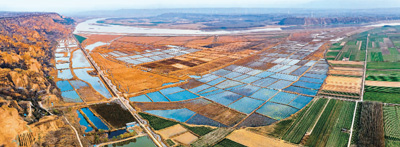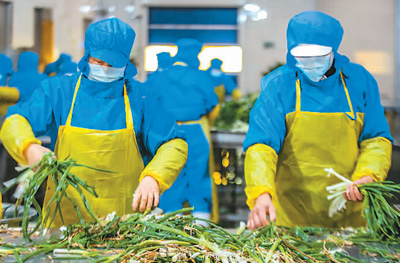Chinese agricultural products with geographical indications win favor with consumers
Agricultural products with geographical indications (GIs), which boast high quality and a good reputation, have become popular among Chinese consumers.

Photo shows mudflats along a section of the Yellow River in Ruicheng county, Yuncheng city, north China’s Shanxi Province. The county produces six kinds of agricultural products with geographical indications. (Photo/Xue Jun)
A resident surnamed Wu in Beijing bought two boxes of Pinggu peaches, a GI product of Pinggu district situated in the country’s capital, and sent them to his friends living elsewhere via an e-commerce platform.
“A 200-gram peach is worth about 4 yuan ($0.59). The unit price is higher than that of an ordinary peach, but Pinggu peaches are very delicious and the taste serves as a memory from my childhood,” Wu said.
Wu added that he has always preferred GI agricultural products, such as Pinggu peaches, Yantai apples, and Korla pears, since he came to realize the unique advantages of such products.
The name of a GI agricultural product is the combination of the name of the region where the product is produced and the common name of the product, according to Zhou Qingjie, executive director of a research institute at the Beijing Technology and Business University, who introduced that the names of GI agricultural products indicate their places of origin and superior quality.
“The development of GI agricultural products has not only brought quality agricultural products to consumers, but also helped improve the reputation of such products, increase farmers’ incomes and promote rural vitalization,” Zhou said.
China has continuously enhanced the protection of GI agricultural products in recent years. According to an official from the Ministry of Agriculture and Rural Affairs (MARA), since the country implemented programs to protect GI agricultural products three years ago, it has supported the protection and development of 634 kinds of GI agricultural products and realized a sales volume of more than 270 billion yuan, which has helped 11.3 million rural households increase their incomes. So far, 62,000 different kinds of green, organic and GI agricultural products have been registered across the country.

Workers in Wangheng village, Xinghua city, east China’s Jiangsu Province, are busy producing Xinghua chives, a kind of geographical indication agricultural product, which will be exported to buyers overseas. (Photo/Tang Dehong)
GI agricultural products have been recognized by more and more consumers. Zhou introduced that the high quality of GI agricultural products is the key to attracting consumers.
Chinese e-commerce platforms have expanded the sales channels for GI agricultural products and have since delivered an eye-catching performance. Fresh food e-commerce platforms, including Hema Fresh and Dingdong Maicai, have actively promoted GI agricultural products.
“We launch a campaign to market GI agricultural products every fiscal year,” said Li Tianyu, head of public relations of Hema Fresh, adding that GI agricultural products on the platform are widely recognized by customers.
In addition, China’s convenient system of logistics services has contributed to brisk sales of GI agricultural products. Thanks to unimpeded logistics, those GI agricultural products with strong seasonality, which were often sold locally in the past, can now be bought and delivered to people’s dining tables faster.
China has rolled out a series of policies to promote the development of GI agricultural products. On May 30, the MARA issued a circular on further implementing programs to protect GI agricultural products, aiming to boost the development of 200 new GI agricultural products.
“These policies serve as references for the development of GI agricultural products,” said Zhou, who suggested establishing a mechanism for tracing the origin of GI agricultural products using digital methods.
China’s GI agricultural products have also gained popularity among overseas customers. Since the China-European Union (EU) Geographical Indications Agreement came into effect in March 2021, 244 China-EU GIs have been mutually recognized and protected, which has boosted exports of Chinese GI agricultural products. For instance, in east China’s Shandong Province, over 550,000 tonnes of Jinxiang garlic, a kind of GI product, have been exported so far this year, up more than 80 percent year-on-year.
Zhou also suggested fostering a development pattern that focuses on the production of GI products and integrates storage, processing, transportation, sales and cultural tourism to promote the coordinated development of GI, tourism, cultural and creative industries, as well as other related industries.
Photos
Related Stories
Copyright © 2022 People's Daily Online. All Rights Reserved.









